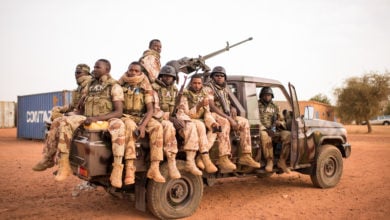On Aug. 8, the government of Pakistan’s military ruler, Gen. Pervez Musharraf, announced that it was considering imposing a state of emergency in response to “external and internal threats.” The announcement highlights the lack of stability of this U.S. client state, which is facing popular opposition.
Pakistan’s present is intricately tied to its history of colonial domination.
|
Pakistan used to be part of India, the jewel in the crown of the vast British Empire. To consolidate their rule, the British colonizers promoted ethnic and religious conflicts between the peoples of India, particularly between Hindus and Muslims.
In 1906, Mohammed Ali Jinnah founded the Muslim League, a party that the British used to sow the seeds of division among the peoples of the subcontinent. When the leaders of the Indian anti-colonial struggle refused to fight on the side of their colonizers in World War II, the Muslim League joined the British.
But following World War II, popular resistance in India grew to such a massive scale that the British were no longer able to hold on. Breaking up India was the next best thing for the colonizers.
The partition crime
On July 18, 1947, the British Parliament passed the Indian Independence Act, relinquishing Britain’s hold over India, but also partitioning India along religious lines.
The Islamic Republic of Pakistan was formed under Jinnah’s rule.
The partition had nothing to do with concern for the rights of India’s Muslim minority. It was a means of weakening what was to become the independent state of India.
The partition caused the largest migration in human history, with 17 million people fleeing across the new border in both directions.
Pakistan is situated in the western part of the Indian subcontinent, with Afghanistan and Iran on the west, India and China on the east and the Arabian Sea on the south. Pakistan’s ports on the Arabian Sea and its borders with Iran, Afghanistan and China make it a strategic country for the United States.
Since its formation, Pakistan has been mostly under military rule, with its brief periods of civilian “democracy” tightly monitored by the military. Pakistan’s rulers have been largely controlled by imperialism, particularly U.S. imperialism in recent decades.
Border tensions
Tensions between India and Pakistan have been ongoing since the very beginning. An issue of constant dispute has been the majority Muslim Kashmir region, divided between the two countries.
In 1970, the Awami League, based in East Pakistan, won a majority of the seats in the national assembly.
Faced with the region’s demand for autonomy, President Yahya Khan postponed the opening of the national assembly. This led to a war with the East Pakistanis, who were fighting for independence. In the final weeks of the war, Indian troops joined in and helped the East Pakistanis gain victory.
On March 26, 1971, the state of Bangladesh was proclaimed.
Pakistan’s defeat in the war destabilized its regime. President Khan stepped down amidst mass uprisings by Pakistan’s working class and poor. The protests and strikes did not lead to revolution, but it prompted Pakistan’s ruling class to put a reformist in power.
In 1973, Zulfiqar Ali Bhutto became prime minister of Pakistan, implementing a program of extensive reforms, including nationalization of major industries and land distribution to poor peasants. When the ruling class decided that reforms were no longer needed, the military took political power.
Gen. Muhammad Zia ul-Haq overthrew Bhutto and declared martial law in 1977. Two years later, Bhutto was executed.
Military rule continued until 1988, when Zia’s plane crashed mysteriously.
In the 1980s, Pakistan was instrumental in the counter-revolution in Afghanistan. It funneled arms and provided
|
Between 1988 and 1999, Pakistan was ruled by civilian leaders. Repeatedly, the prime minister’s elected cabinet would get removed by the president.
Benazir Bhutto, the daughter of the deposed president, and Nawaz Sharif each had two short tenures as prime minister.
The overthrow of the Soviet Union led to a rightward shift in Indian politics. This meant that Pakistan lost the special position it formerly had with the United States as a counterweight to India.
The United States began to court India’s new leaders to bolster India against China. Pakistan maintained its value for other reasons.
Following the collapse of Kabul’s leftist regime in 1992, Afghanistan went through four years of being ruled by the Mujahedeen, the CIA’s “freedom fighters.”
With the deterioration of the situation in Afghanistan, Pakistan’s intelligence service, the ISI, became the architect of the Taliban’s formation. With U.S. support, the ISI helped the Taliban capture most of Afghanistan in 1996.
Two years later, just weeks after India had conducted underground nuclear explosions, Pakistan successfully tested its own nuclear bomb.
In 1999, Gen. Musharraf led a coup against Prime Minister Nawaz Sharif and reinstated direct military rule. Musharraf has since declared himself president while maintaining command of the military, in violation of Pakistan’s constitution.
Contradictions exposed
Pakistan has a population of 160 million. Approximately one-third of its population lives below the poverty line—13 percent of the population survives on less than $1 a day.
A 7.5 magnitude earthquake shook northern Pakistan in 2005. The earthquake exposed the contradictions of the
|
The rural population living mostly in mud houses was devastated. Conservative estimates put the death toll at 80,000. The area was so undeveloped that international aid agencies could not reach many of the victims.
The country’s notoriously corrupt rulers had spent decades enriching themselves at the expense of the impoverished working class and peasants. In addition, Pakistan had spent outsized sums on its military, including developing its nuclear capacity.
Musharraf then made headlines around the world in September 2006 after an interview on “60 Minutes.” He revealed that Richard Armitage, U.S. deputy secretary of state at the time, had threatened him to “be prepared to be bombed. Be prepared to go back to the Stone Age.”
Candid exchanges like this reveal the real relations between imperialists and their clients.
The reason Armitage threatened Musharraf was that Pakistan still had close ties to the Taliban. In the new “war on terror,” Washington needed to invade Afghanistan as a stepping-stone toward “redrawing the map of the Middle East.” Pakistan’s ties with the Taliban had to be broken.
Despite its new understanding with the United States, survival of Musharraf’s regime is uncertain.
In March 2007, Musharraf removed chief justice Iftakar Mohammed Chaudhry from office. Chaudhry’s “indiscretion” was that he had agreed to hear cases involving disappearances of people detained by intelligence agencies, as well as constitutional challenges involving Musharraf’s rule.
There were street demonstrations protesting Chaudry’s ouster. Pakistan’s Supreme Court reinstated Chaudry in July.
That same month, the military attacked the Lal Masjid, or Red Mosque, a religious teaching institution. Government troops stormed the compound and killed 80 people. Protests and violence erupted in response to the raid.
While Pakistan is not considered part of the Middle East, what Pakistan shares with the majority of that region’s states is rule by an unpopular, repressive administration that takes its orders from Washington.
Much like the governments in Egypt, Jordan, Saudi Arabia and other countries, Musharraf’s regime is engaged in a balancing act between implementing the dictates of his imperialist masters and keeping the potentially explosive mass opposition at bay.
The people of Pakistan will determine how long the country’s leaders will be able to continue their despotic rule.







